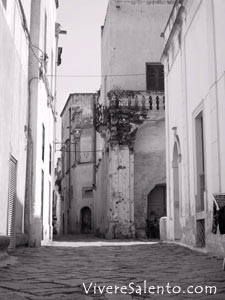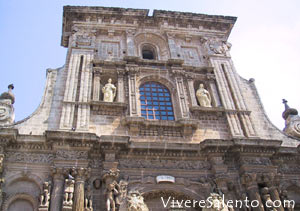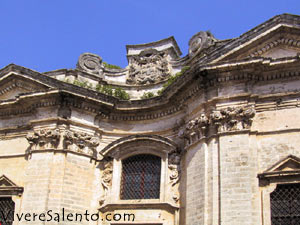|
|

| Inhabitants'
name: Neretini |
The civic coat of arms of Nard˛ is characterized by a bull
lifting a leg on a source of water and a Latin
 inscription.
The old name of the village was ĹNeretumĺ, it would come from "nar", water. A
legend says that a large group of people were wandering in order to find a place
where to settle. They had some animals with them and suddenly a bull began to
scratch the earth and, short after, the water was gushing. They thought that was
a good sign and decided to settle there and founded a village called Neretum.
This is what the legend says but the territory of Nard˛ is rich in
archaeological finds. The finds of the Cave of Venus and the Cave of the Figus
date to the pre-messapic period. Those of the Grotta di Uluzzu date back to the
Palaeolithic period. The rests of a village of the Age of Bronze were found near
Nard˛ and other finds date to Neolithic period. Neretum was a pre-messapic town
in the 269 a.C., then it was besieged and conquered by the Romans and the
village was on the Via Traiana- Appia. When the Byzantines came, the religious
institutions flourished in the hands of the Basilian monks. The Normans came in
1055, after the Longobards, with Sanfrido, the first count of Nard˛. Goffredo
succeeded him, he built the Cathedral the fortified the town. The first
feudatory were the Gentiles and the feud was given them by Federico II in 1212.
When the king was excommunicated the inhabitants of Nard˛ rose against the
Gentiles. inscription.
The old name of the village was ĹNeretumĺ, it would come from "nar", water. A
legend says that a large group of people were wandering in order to find a place
where to settle. They had some animals with them and suddenly a bull began to
scratch the earth and, short after, the water was gushing. They thought that was
a good sign and decided to settle there and founded a village called Neretum.
This is what the legend says but the territory of Nard˛ is rich in
archaeological finds. The finds of the Cave of Venus and the Cave of the Figus
date to the pre-messapic period. Those of the Grotta di Uluzzu date back to the
Palaeolithic period. The rests of a village of the Age of Bronze were found near
Nard˛ and other finds date to Neolithic period. Neretum was a pre-messapic town
in the 269 a.C., then it was besieged and conquered by the Romans and the
village was on the Via Traiana- Appia. When the Byzantines came, the religious
institutions flourished in the hands of the Basilian monks. The Normans came in
1055, after the Longobards, with Sanfrido, the first count of Nard˛. Goffredo
succeeded him, he built the Cathedral the fortified the town. The first
feudatory were the Gentiles and the feud was given them by Federico II in 1212.
When the king was excommunicated the inhabitants of Nard˛ rose against the
Gentiles. In 1255 the Saracens attacked the village and Manfredi, Federico IIĺs son,
joined the Saracens and gave back the feud to his father. Several other families
ruled the town, the Tuzziacos, the Guidones, the DĺAlemagnas, the Angevins, the
Orsini del Balzos, the Sanseverinos, then came Fedinando DĺAragona and again the
Del Balzos. In 1497 the town was ruled by Andrea Matteo Acquaviva. Belisario
succeeded him and became duke. His family ruled for three centuries, till 1806
when the feudal system came to end. During the government of the Acquavivas
Nard˛ had an important economic and cultural recovery. Also the religious orders
grew: the Friars Minor (1497), the Carmelites (16th century), the Capuchins
(17th century), the Augustinians and the Carmelites (17th century).
In 1255 the Saracens attacked the village and Manfredi, Federico IIĺs son,
joined the Saracens and gave back the feud to his father. Several other families
ruled the town, the Tuzziacos, the Guidones, the DĺAlemagnas, the Angevins, the
Orsini del Balzos, the Sanseverinos, then came Fedinando DĺAragona and again the
Del Balzos. In 1497 the town was ruled by Andrea Matteo Acquaviva. Belisario
succeeded him and became duke. His family ruled for three centuries, till 1806
when the feudal system came to end. During the government of the Acquavivas
Nard˛ had an important economic and cultural recovery. Also the religious orders
grew: the Friars Minor (1497), the Carmelites (16th century), the Capuchins
(17th century), the Augustinians and the Carmelites (17th century).
 In
1647 the people of Nard˛ rose against the feudatory but they were stopped by the
soldiers of the Duke Gian Girolamo Acquaviva and also several priests were
imprisoned and executed. Among the famous people of Nard˛ we can remember:
Francesco Castrignan˛, Renata Fonte, Pantaleo Ingusci, Michele Maria Tenuto. A
special mention also to Antonio Caraccio and Mauro Manieri. The first was born
in 1630 in a wealthy family. The father wanted him to become a magistrate but he
had a bent for writing poetry and novels and the town of Venice made him Knight
of St Marco because of his beautiful poem on the town. He moved in Naples where
he worked in the Accademia Filosofica degli Investiganti and died in 1702. Mauro
Manieri was an important artist of the baroque and rococo style and he worked at
the most beautiful churches of the Salento. In
1647 the people of Nard˛ rose against the feudatory but they were stopped by the
soldiers of the Duke Gian Girolamo Acquaviva and also several priests were
imprisoned and executed. Among the famous people of Nard˛ we can remember:
Francesco Castrignan˛, Renata Fonte, Pantaleo Ingusci, Michele Maria Tenuto. A
special mention also to Antonio Caraccio and Mauro Manieri. The first was born
in 1630 in a wealthy family. The father wanted him to become a magistrate but he
had a bent for writing poetry and novels and the town of Venice made him Knight
of St Marco because of his beautiful poem on the town. He moved in Naples where
he worked in the Accademia Filosofica degli Investiganti and died in 1702. Mauro
Manieri was an important artist of the baroque and rococo style and he worked at
the most beautiful churches of the Salento.
|